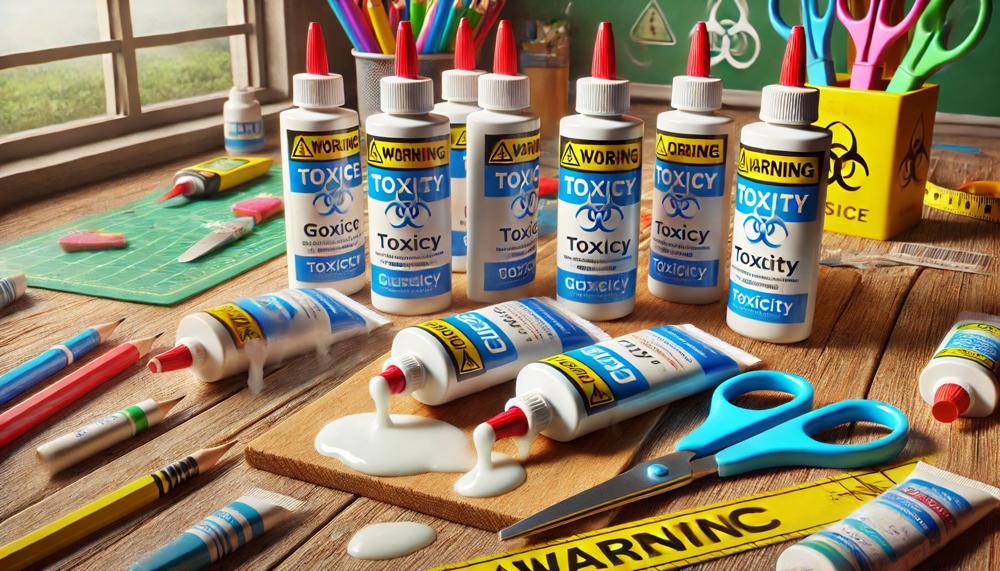No, but there are important caveats to consider. Glue sticks, commonly found in classrooms and homes, are designed to be safe for use, but they are not meant to be consumed. Here are the key points to keep in mind:
- Non-Toxic Ingredients: Most glue sticks are made from materials like polyvinyl acetate (PVA) or ethylene-vinyl acetate (EVA), along with wax and preservatives. These components are generally non-toxic, meaning that accidental ingestion of a small amount is unlikely to cause significant harm.
- Choking Hazard: The primary risk associated with glue sticks is choking, particularly for young children. The solid form of glue sticks can easily become lodged in a child’s throat if swallowed.
- Digestive Issues: While the ingredients are not highly toxic, consuming a significant amount can cause stomach discomfort, vomiting, or even a blockage in the digestive tract.
- Allergic Reactions: Though rare, some individuals may have allergic reactions to certain additives in glue sticks, leading to irritation in the mouth or throat.
- Medical Attention: If a large amount is ingested or if there are signs of an adverse reaction, it’s crucial to seek medical attention immediately.
Glue sticks are safe when used as intended, but it’s essential to keep them out of reach of young children and to supervise their use. For added safety, consider opting for non-toxic or natural alternatives in your arts and crafts projects.
Table of Contents
What Happens If You Eat Glue?
Eating glue sticks is generally not safe, though they are often labelled as non-toxic. Made primarily from materials like polyvinyl acetate (PVA), which is deemed safe for household use, ingestion can still lead to health risks.
| Potential Effects | Details | Action Required |
| Mild Discomfort | Stomach discomfort, nausea, or minor digestive upset. | No immediate action needed unless symptoms persist. Monitor the individual. |
| Choking Hazard | Risk of choking, especially in young children. | Ensure the person can breathe. Perform the Heimlich maneuver if necessary and seek medical help. |
| Allergic Reaction | Possible irritation or allergic reaction in the mouth, throat, or digestive tract. | If swelling or difficulty breathing occurs, seek emergency medical attention immediately. |
| Digestive Blockage | Large amounts can cause blockage in the intestines. | Seek immediate medical attention if there are signs of blockage, such as severe pain or inability to pass stool. |
While glue sticks are designed to be safe for use in arts and crafts, they should not be ingested. Here are some additional points to consider:
- Composition: Glue sticks often contain polymers like PVA, EVA, and various additives. These are safe for external use but not for ingestion.
- Children: Always supervise children using glue sticks and keep them out of reach to prevent accidental ingestion.
- Medical Advice: If ingestion occurs and any adverse symptoms are observed, contact a medical professional promptly.
- Non-Toxic Label: Non-toxic does not mean edible. The label indicates it is safe for skin contact and inhalation in small quantities but not for consumption.
The Dangers of Eating Glue
Consuming glue sticks poses several potential health risks, even though they are generally considered non-toxic. The main dangers stem from the physical properties of the glue and the chemicals it contains.
Health Risks Associated with Consuming Glue Sticks
| Risk | Description | Possible Symptoms |
| Choking Hazard | Glue sticks can block airways, especially in children, leading to choking. | Difficulty breathing, coughing, gagging |
| Gastrointestinal Blockage | Ingested glue can harden in the digestive tract, causing blockages. | Abdominal pain, constipation, vomiting |
| Minor Toxicity | Although non-toxic, ingestion of large quantities can cause mild poisoning symptoms. | Nausea, vomiting, diarrhoea |
| Allergic Reactions | Some individuals may have allergic reactions to components in the glue. | Rash, itching, swelling |
How Much Glue Can Be Harmful?
Ingesting glue sticks, while seemingly benign, can pose significant health risks. The severity of these risks hinges on the type of glue and the amount ingested.
Potential Risks of Ingesting Glue Sticks
- Choking Hazard: Glue sticks can obstruct the airway, leading to choking, particularly in children.
- Gastrointestinal Blockage: Ingesting a glue stick can result in blockages in the digestive tract, necessitating medical intervention.
- Minor Toxicity: Although most school glue sticks are labelled non-toxic, they can still cause nausea, vomiting, and abdominal pain if ingested.
- Allergic Reactions: Some individuals may experience allergic reactions to the components of the glue, including skin rashes or respiratory distress.
How Much Glue is Harmful?
The harmfulness of ingested glue varies based on its toxicity and quantity. Here’s a breakdown:
| Type of Glue | Potential Harm | Symptoms |
| Non-Toxic Glue Sticks | Minor to Moderate | Nausea, vomiting, abdominal pain, possible choking |
| Industrial-Strength Adhesives | Severe | Respiratory issues, poisoning, gastrointestinal blockages |
| Super Glue (Cyanoacrylate) | Severe | Intestinal blockages, chemical burns, systemic toxicity |
Immediate Actions and Treatment
- Identify the Glue Type: Check the label for toxicity information.
- Seek Medical Attention: If ingestion occurs, particularly with industrial or super glues, seek prompt medical care.
- Monitor Symptoms: Look for signs of choking, allergic reactions, or severe abdominal pain.
Prevention Tips
- Proper Storage: Keep glue out of reach of children and pets.
- Education: Teach children about the dangers of ingesting non-food items.
- Safe Use: Always supervise young children when using glue sticks for crafts.
What to Do in Case of Glue Ingestion
Common Symptoms of Glue Ingestion
| Symptom | Description | Action |
| Gastrointestinal | Nausea, vomiting, abdominal pain | Seek immediate medical help, do not induce vomiting unless instructed by a healthcare provider |
| Respiratory | Difficulty breathing, runny nose, coughing | Move to fresh air, seek medical help if symptoms persist |
| Neurological | Dizziness, headaches, irritability, seizures, stupor | Seek emergency medical assistance |
| General | Loss of appetite, excitability, anxiety, coma | Immediate medical attention required |
Response Actions
- Do Not Induce Vomiting: Unless specifically advised by a healthcare provider, do not induce vomiting as it can cause further harm.
- Seek Medical Attention: Contact emergency services or go to the nearest hospital if any severe symptoms are present.
- Move to Fresh Air: If glue fumes have been inhaled, move the person to an area with fresh air immediately.
- Monitor Symptoms: Keep an eye on the affected person’s symptoms and provide details to medical personnel.
- Stay Calm and Reassure: It’s important to keep the person calm and reassure them while waiting for medical help.
Medical Treatment for Glue Ingestion
When it comes to treating glue stick ingestion, the approach varies based on the type of glue and the symptoms presented. Here’s a detailed breakdown:
Immediate Actions
- Do Not Induce Vomiting: Vomiting can cause further harm, especially if the glue is toxic.
- Seek Medical Help: Contact emergency services or poison control immediately.
- Fresh Air: If the person has inhaled fumes, move them to fresh air promptly.
- Monitor Symptoms: Stay calm and keep an eye on symptoms like nausea, vomiting, or difficulty breathing.
Medical Interventions
Upon reaching a healthcare facility, the following treatments might be administered:
| Treatment | Description | Purpose |
| Activated Charcoal | Administered to absorb the glue in the stomach. | Reduces the absorption of toxins. |
| Gastric Lavage | A procedure where the stomach is washed out. | Used in severe cases to remove toxic substances. |
| Hydration Therapy | IV fluids are given to maintain hydration and support kidney function. | Helps to flush out toxins and support vital organs. |
| Symptomatic Treatment | Medications to manage symptoms like pain, nausea, or allergic reactions. | Ensures patient comfort and addresses specific symptoms. |
Long-term Monitoring
Even if initial symptoms seem mild, long-term monitoring is essential due to potential delayed effects on vital organs like the heart, kidneys, brain, and liver. Regular follow-up appointments and tests may be required to ensure no lasting damage has occurred.
Preventing Glue Ingestion
To prevent accidental ingestion of glue sticks, follow these strategies:
- Education: Teach children about the dangers of consuming glue. Make sure they understand glue is for crafts, not consumption.
- Proper Storage: Keep glue sticks and other adhesives out of reach of young children. Use locked cabinets or high shelves.
- Supervision: Always supervise young children during craft activities to ensure they use glue safely.
- Labelling: Clearly label glue containers as non-edible and potentially harmful if ingested.
In case of accidental ingestion, follow these steps:
| Action | Details | Why |
| Assess the Situation | Determine the amount and type of glue ingested. | Non-toxic glue sticks may cause minor symptoms, while toxic adhesives require urgent care. |
| Do Not Induce Vomiting | Avoid making the person vomit unless directed by a healthcare professional. | Vomiting can cause further damage or complications. |
| Rinse Mouth | Rinse the mouth with water to remove any remaining glue. | This helps to reduce any immediate oral irritation. |
| Contact Poison Control | Call your local poison control centre for specific advice based on the glue type. | Experts can provide tailored guidance and next steps. |
| Seek Medical Attention | If severe symptoms occur or if toxic glue was ingested, go to the emergency room. | Timely medical intervention can prevent serious health complications. |
Conclusion

Glue sticks, a staple in classrooms and homes, pose minimal toxicity risks if accidentally ingested, thanks to their non-toxic ingredients like polyvinyl acetate (PVA) and ethylene-vinyl acetate (EVA). However, this doesn’t mean they’re harmless.
The primary concern with glue sticks is their potential to cause choking, especially in young children who might try to swallow them. The solid form can easily obstruct the airway, creating a dangerous situation that requires immediate medical attention.
Ingesting glue sticks can also lead to digestive issues. While small amounts might only cause mild stomach discomfort or nausea, consuming larger quantities can result in vomiting or even a blockage in the digestive tract, necessitating professional medical intervention.
Moreover, some individuals might experience allergic reactions to certain additives in glue sticks. Symptoms like mouth or throat irritation and, in rare cases, more severe allergic responses can occur.
To ensure safety, always keep glue sticks out of reach of young children and supervise their use during arts and crafts activities. Opting for non-toxic or natural alternatives can add an extra layer of precaution.






